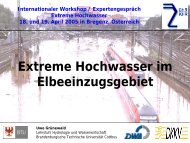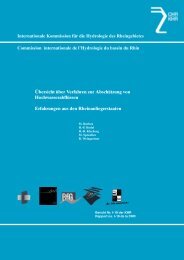ABSTRACTS 'Extreme Discharges' - CHR-KHR
ABSTRACTS 'Extreme Discharges' - CHR-KHR
ABSTRACTS 'Extreme Discharges' - CHR-KHR
Create successful ePaper yourself
Turn your PDF publications into a flip-book with our unique Google optimized e-Paper software.
cm for M95++). It is important to understand that consideration of the possible retention polders upstream<br />
of Maxau would yield an additional reduction in the range of 10 cm, in particular for the Upper Rhine<br />
area.<br />
- The unrealistic, extreme land-use scenario (50% increase of urban areas) would result in a water level<br />
increase not much more than 10cm.<br />
- The M95+ and even more the M95++ scenario results in higher reduction of flood levels in the case where<br />
the flood polders are active. This is due to the fact that according to the operation rules, the flood polders<br />
are to be filled only if flood discharge exceeds the 200-year value. In January/February 1995 (M95) the<br />
flood discharge along most stretches of the Rhine was above the 100-year value, but below 200 years.<br />
That is why the polders were used only at a few stretches resulting in small water level reduction only.<br />
Some more general results from the whole study are summarised in the following:<br />
(1) At the lower meso-scale level the influence of land-use on storm-runoff generation is stronger for convective<br />
storm events with high precipitation intensities than for long advective storm events with low precipitation<br />
intensities, because only storm events associated with high rainfall intensities are at least partially<br />
controlled by the conditions of the land-cover and/or the soil-surface. Convective storm events, however,<br />
are of minor relevance for the formation of floods in the large river basins of Central Europe because the<br />
extent of convective storms is usually local.<br />
(2) An estimated, rather dramatic, further increase of urban areas of about 50% may result in an increase of<br />
medium-size flood peak discharge (e.g. return intervals between 2 and 8 years) in catchments of the lower<br />
meso-scale (up to ca. 1000 km²):<br />
⎯<br />
Between 0% and 4% for advective rainfall events, and<br />
⎯ up to 30% for convective rain storms.<br />
(3) The flood impacts due to a more realistic representation of urbanisation increase are in the order of 1 to 5<br />
cm in the main channel, while the effects are even less for extreme rainfall amounts.<br />
(4) The decentralised storage, detention, and infiltration of urban storm water yields reduction of flood peaks<br />
in catchments of the lower meso-scale which are about the same size as the increase due to urbanisation.<br />
(5) The superposition of flood waves originating in different sub-basins shows that the maximum effect of<br />
water retention in the landscape generally occurs in the rising limb of the flood wave in the main channel.<br />
The flood mitigation effect at the peak is considerably smaller.<br />
(6) Water retention measures in polders along the Upper and Lower Rhine, under the given boundary conditions,<br />
yield flood peak attenuation along the Rhine all the way down to Lobith of between 1 cm and 15cm. The<br />
optimised and co-ordinated control of the polders can result in a considerable stronger decrease of the peaks.<br />
Final report:<br />
Bronstert, A., Bárdossy, A:, Bismuth, C., Buiteveld, H., Busch, N., Disse, M., Engel, H., Fritsch, U., Hundecha,<br />
Y., Lammersen, R., Niehoff, D., Ritter, N., (2003): Quantifizierung des Einflusses der Landoberfläche<br />
und der Ausbaumaßnahmen am Gewässer auf die Hochwasserbedingungen im Rheingebiet. Reports of<br />
the <strong>CHR</strong>, Series II, No. 18, 78pp.<br />
68





